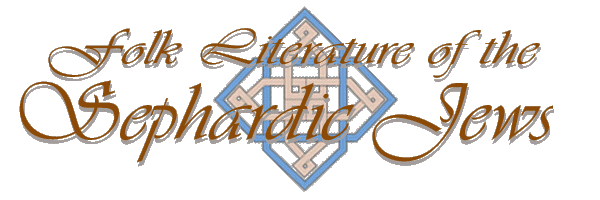Oral Literature of the Hispanic World
Samuel G. Armistead, Faculty Research Lecture, 1998, University of California, Davis
Dedication and Acknowledgments
The Nature of the Pan-Hispanic Ballad
The 700-Year Oral Tradition of the Pan-Hispanic Ballad: A Case Study
Enter Judeo-Spanish: A Living Matrix of Pan-Hispanic Ballad Traditions
Medieval Epic and the Ballad: An Example
The Invention of Tradition: A Case of "False Memory"
Creative Cultural Fusions: "Orientalizing" the Ballad Melody
Creative Cultural Fusions: "Orientalizing" the Ballad Melody
And as our work went forward, we were to discover something that had never been noticed before. Various ballads sung in the Eastern Sephardic communities--ballads that, in every way, look like authentic medieval survivals--turned out, in fact, to be quite close translations from Modern Greek. In the Eastern communities, the Spanish Jews had, as their close, immediate neighbors, Greeks, Turks, South Slavs, Albanians, and other Balkan peoples. In Morocco, their neighbors spoke Arabic. The influence of these peoples has been crucially important to the development of Sephardic traditional poetry. And this has turned out to be very much the case, not only with texts, but also, as my friend Professor Katz has shown, with the music to which Sephardic ballads are sung. Here is one example of the "Orientalization" of ballad music. This is a Judeo-Spanish version of the ballad of The Husband's Return. It can be traced back to medieval Spanish antecedents and ultimately to a lost Old French archetype. But if we were to disregard the Spanish words and concentrate our attention on the music alone, we could easily be convinced that this is a Near Eastern, a Turkish, or an Arabic song. The singer is playing a stringed instrument, the Turkish ud, as an accompaniment. (This is the Arabic word and the Arabic instrument that entered Western European communities as the lute): (click on the links to hear each segment)
| 4. La vuelta del marido (í) | The Husband's Return | Play Audio Segment | |
| ¡Arvoleras, arvoleras, ¡amán! | Tree, tree, noble tree, | Play Audio for Segment Download MP3 Audio File | |
| arvoleras tan g,[caron])entil! | such a noble tree! | ||
| 2 | La raís tienéx de oro, ¡amán! | Your roots are of gold, | |
| la simiente de marfil. | your base of ivory. | ||
| Por ayí pasó un cavayero, | A knight passed by, | Play Audio for Segment Download MP3 Audio File | |
| cavayero d'Amadí: | a knight called Amadí: | ||
| 4 | --¿Qué buxcáx, la mi señora? ¡ah, amán! | What are you looking for, my lady? | |
| ¿Qué buxcáx vos por aquí? | What are you looking for here?" | ||
| --Buxco yo al mi querido, ¡amán! | "I am searching for my beloved, | ||
| mi querido Amadí. [. . .] | my beloved Amadí." [. . .] | ||
| 6 | Vos daré las tres mis hijas, ¡amán! | "I will give you my three daughters, | |
| tres mis hijas d'Amadí: | three daughters of Amadí. | ||
| La una para la meza, ¡amán! | One for the table, | Play Audio for Segment Download MP3 Audio File | |
| la sigunda para servir, | the other to serve, | ||
| 8 | la tresera, la más chiquitica d'eyas, ¡amán! | the third, the youngest, | |
| para holgar y para dormir. [. . .] | to sleep with you." [. . .] | ||
| Él ya abaxó di el cavayo, ¡amán! | He got off his horse | Play Audio for Segment Download MP3 Audio File | |
| s'asercó y a donde mí. | and approached me. | ||
| 10 | Miramos cara con cara, ¡amán! | We looked at each other face to face. | |
| [. . . . . . . . . .] | [. . . . . . . . . .] | ||
| --¡Ah,! Tú sos el mi querido, ¡amán! | "Oh, you are my beloved, | ||
| que yo tanto te asufrí. | for whom I have waited so long. | ||
| 12 | ¡Bendicho el Patrón del Mundo, | Blessed be the Lord of the World, | |
| que vos traxo para mí! | Who brought you back to me!" |
In the light of such texts as this one, the Sephardic tradition emerges, not only as a marvelous treasure trove of multi-secular medieval survivals, but rather as a rich, pluralistic, living, and constantly evolving creative tradition, a synthesis of Hispanic and Near Eastern elements, a tradition which faithfully mirrors all the diverse cultural contacts, the many adventures, experienced by the Sephardic people, during half a millennium, since they were forced to depart from their Spanish homeland.

 Software development and hosting is currently provided by the
Software development and hosting is currently provided by the